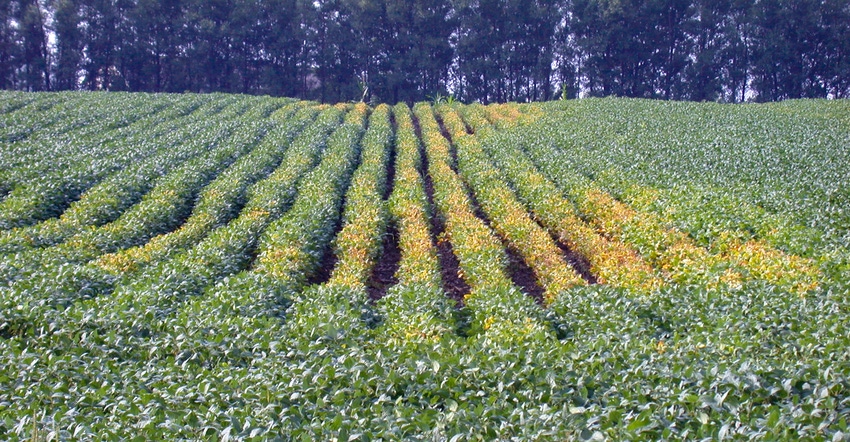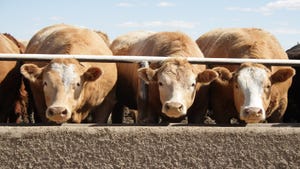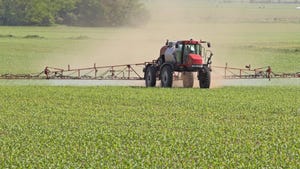
Worried about a possible soybean cyst nematode infection in your fields? Start with testing your soils.
Penn State Extension offered a free test program for SCN in 2019 and it appears that the testing will be offered once again in 2020.
SCN is the No. 1 economic threat to soybeans and can wipe out entire fields if not properly managed, according to Heidi Reed, agronomy Extension educator at Penn State.
“When they are infesting your fields, you want to be looking for signs of infestation, not the worm itself,” she says.
Signs of infection can include yellowing of fields — making it look a nutrient deficiency — and patches of dead plants. Since the microscopic critters can only move from field to field attached to machinery, Reed says producers should look for yellow patches that move in the direction of where a machine was operating. This can be a giveaway that a problem with SCN is present.
SCN can also cause yield declines in soybeans even in places where there is very good nutrient management.
Environmental factors
There have to be enough SCN in the soil to cause problems, but plant stress can exacerbate the problem.
Reed says that sandy soils, which often don’t hold water as well as other soils, are especially prone to infection because plants are under stress in summer, especially in fields that aren’t irrigated.
Plant population density is another factor. If soybean plant densities are high, there will be more competition for nutrients and water, creating more stress.
Low-lying fields that get flooded are also more susceptible to infection.
Rapid spread, bad results
SCN was first discovered in North Carolina in 1954, she says. Since then, it has spread rapidly to many areas, especially in the Corn Belt.
The pest has started to invade the Mid-Atlantic and Northeast. It is widespread in Delmarva and pockets of Maryland.
It has also spread to parts of Pennsylvania, New Jersey and even pockets of New York state. Reed says that since 2014, SCN has been confirmed in at least two counties in Pennsylvania: Lancaster and Franklin.
"We are at risk, we have the right environment for these guys to thrive and cause trouble,” she says. “So we need to arm ourselves.”
Preventing infection
“If you don’t sample, you won’t know they are there,” she says.
Reed suggests soil sampling at least once every three years and taking action based on those tests.
Planting a resistant soybean variety can help along with rotating a field to a nonhost crop, which depends on the species of nematode found and nonhost crops for that species.
Nematicides can also be effective, she says.
Another thing to look at is weed control. A lot of winter annual broadleafs — such as field pennycress, shepherd’s purse and common chickweed — are all hosts for SCN. Good weed control and keeping plants stress-free is a good management practice, she says.
Plant-parasitic nematodes — of which SCN is one — feed on plant roots. They select a cell and use it as a feeding center, effectively taking away sugars and water from the plant root.
Nematodes can spread rapidly. In the spring, juveniles hatch out of eggs and within a couple of days will find a host, or die, and will attach themselves to a root to start feeding.
If they are female, they will continue feeding and will send out a chemical signal to male nematodes for mating. A female nematode can produce up to 400 eggs, most of which can overwinter in the soil.
The entire process takes around 24 days, so Reed says you can see up to six generations of the SCN in a given year.
Sampling tips
According to Penn State Extension, the easiest way to collect soil samples for nematodes is with a soil probe.
If you don’t have access to a soil probe, subsamples can be collected with a spade or a trowel at 8 inches deep. If the soil will be collected in a field where soybeans were grown the previous year, take samples from within the row, in the root zone, where chances of finding cysts are highest.
If the field has not been sampled for SCN, start by sampling areas of high risk of introduction, like field entry ways, areas prone to flooding and along fence lines.
Go online if you have questions about testing, or contact your county Extension educator
Read more about:
Soybean Cyst NematodeAbout the Author(s)
You May Also Like






